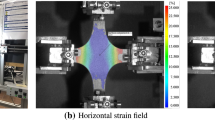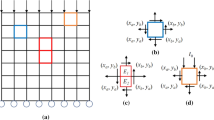Abstract
The material identification problem addressed consists of determining the constitutive parameters distribution of a linear elastic solid using displacement measurements. This problem has been considered in important applications such as the design of methodologies for breast cancer diagnosis. Since the resolution of real life problems involves high computational costs, there is great interest in the development of efficient methods. In this paper two new efficient formulations of the problem are presented. The first formulation leads to a second-order cone optimization problem, and the second one leads to a quadratic optimization problem, both allowing the resolution of the problem with high efficiency and precision. Numerical examples are solved using synthetic input data with error. A regularization technique is applied using the Morozov criterion along with an automatic selection strategy of the regularization parameter. The proposed formulations present great advantages in terms of efficiency, when compared to other formulations that require the application of general nonlinear optimization algorithms.



















Similar content being viewed by others
References
Auger, A., Hansen, N., Perez Zerpa, J.M., Ros, R., Schoenauer, M (2009) Experimental comparisons of derivative free optimization algorithms. In: Lecture notes in computer science. vol 5526. Springer, pp 3–15. doi:10.1007/978-3-642-02011-7_3
Avril S, Badel P, Duprey A (2010) Anisotropic and hyperelastic identification of in vitro human arteries from full-field optical measurements. J Biomech 43(15):2978–2985. doi:10.1016/j.jbiomech.2010.07.004
Avril S, Bonnet M, Bretelle AS, Grédiac M, Hild F, Ienny P, Latourte F, Lemosse D, Pagano S, Pagnacco E, Pierron F (2008) Overview of Identification methods of mechanical parameters based on full-field measurements. Exp Mech 48(4):381–402. doi:10.1007/s11340-008-9148-y
Ayachit U (2015) The paraview guide: a parallel visualization application. Kitware, Incorporated, New York
Banerjee B, Walsh TF, Aquino W, Bonnet M (2013) Large scale parameter estimation problems in frequency-domain elastodynamics using an error in constitutive equation functional. Comput Method Appl Mech Eng 253:60–72. doi:10.1016/j.cma.2012.08.023.http://www.pubmedcentral.nih.gov/articlerender.fcgi?artid=3501763&tool=pmcentrez&rendertype=abstract http://linkinghub.elsevier.com/retrieve/pii/S0045782512002770
Barbone PE, Gokhale NH (2004) Elastic modulus imaging: on the uniqueness and nonuniqueness of the elastography inverse problem in two dimensions. Inverse Problems 20(1):283–296. doi:10.1088/0266-5611/20/1/017. http://stacks.iop.org/0266-5611/20/i=1/a=017?key=crossref.d13f22fe48062b2a982ee068f0b414ff
Beck A, Ben-Tal A, Tetruashvili L (2009) A sequential parametric convex approximation method with applications to nonconvex truss topology design problems. J Global Optim 47(1):29–51. doi:10.1007/s10898-009-9456-5. http://link.springer.com/10.1007/s10898-009-9456-5
Ben-Tal, A., Nemirovski, A (2001) Lectures on modern convex optimization: analysis, algorithms, and engineering applications. Soc Indust Appl Math. http://citeseerx.ist.psu.edu/viewdoc/summary?doi=10.1.1.134.932\(\backslash \)n http://books.google.com/books?hl=en&lr=&id=M3MqpEJ3jzQC&oi=fnd&pg=PR11&dq=Lectures+on+modern+convex+optimization+analysis+algorithms+and+engineering+applications&ots=O3kXEzlTWO&sig=pCxNy7L7k
Bonnet M, Constantinescu A (2005) Inverse problems in elasticity. Inverse Problems 21(2):R1–R50. doi:10.1088/0266-5611/21/2/R01. http://stacks.iop.org/0266-5611/21/i=2/a=R01?key=crossref.bba85b522a27b076dd96d50bff83e189
Canelas A, Laurain A, Novotny AA (2014) A new reconstruction method for the inverse potential problem. J Comput Phys 268:417–431. doi:10.1016/j.jcp.2013.10.020. http://www.sciencedirect.com/science/article/pii/S0021999113006967 http://linkinghub.elsevier.com/retrieve/pii/S0021999113006967
Chandran K, Mun J, Choi K, Chen J, Hamilton A, Nagaraj A, McPherson D (2003) A method for in-vivo analysis for regional arterial wall material property alterations with atherosclerosis: preliminary results. Medical Eng Phys 25(4):289–298. doi:10.1016/S1350-4533(02)00224-2. http://linkinghub.elsevier.com/retrieve/pii/S1350453302002242
Cottin N, Felgenhauer HP, Natke HG (1984) On the parameter identification of elastomechanical systems using input and output residuals. Ingenieur-Archiv 54(5):378–387. doi:10.1007/BF00532820
Curnier A (1994) Computational methods in solid mechanics. Springer, Berlin
De Korte CL, Pasterkamp G, van der Steen AFW, Woutman HA, Bom N (2000) Characterization of plaque components with intravascular ultrasound elastography in human femoral and coronary arteries in vitro. Circulation 102(6):617–623. doi:10.1161/01.CIR.102.6.617. http://www.ncbi.nlm.nih.gov/pubmed/10931800
Doyley MM (2012) Model-based elastography: a survey of approaches to the inverse elasticity problem. Phys Med Biol 57(3):R35–R73. doi:10.1088/0031-9155/57/3/R35. http://www.pubmedcentral.nih.gov/articlerender.fcgi?artid=3374584&tool=pmcentrez&rendertype=abstract http://stacks.iop.org/0031-9155/57/i=3/a=R35?key=crossref.7ae4f9dca2362a456e81960acc8e7269
Doyley MM, Meaney PM, Bamber JC (2000) Evaluation of an iterative reconstruction method for quantitative elastography. Phys Med Biol 45(6):1521–1540. doi:10.1088/0031-9155/45/6/309. http://stacks.iop.org/0031-9155/45/i=6/a=309?key=crossref.9194c8e8a482d0463d79d0c647143fd0
Florentin E, Lubineau G (2010) Identification of the parameters of an elastic material model using the constitutive equation gap method. Comput Mech 46(4):521–531. doi:10.1007/s00466-010-0496-y
Franquet A, Avril S, Le Riche R, Badel P (2012) Identification of heterogeneous elastic properties in stenosed arteries: a numerical plane strain study. Comput Method Biomechd Biomed Eng 15(1):49–58. doi:10.1080/10255842.2010.547192
Franquet A, Avril S, Le Riche R, Badel P, Schneider FC, Li ZY, Boissier C, Favre JP (2013) A new method for the in vivo identification of mechanical properties in arteries from cine MRI images: theoretical framework and validation. IEEE Trans Med Imaging 32(8):1448–1461. doi:10.1109/TMI.2013.2257828
Geuzaine C, Remacle JF (2009) Gmsh: a three-dimensional finite element mesh generator with built-in pre- and post-processing facilities. Int J Num Methods Eng 79(11):1309–1331. doi:10.1002/nme.2579
Geymonat G, Pagano S (2003) Identification of mechanical properties by displacement field measurement: a variational approach. Meccanica 38(5):535–545. doi:10.1023/A:1024766911435
Goenezen S, Barbone P, Oberai AA (2011) Solution of the nonlinear elasticity imaging inverse problem: the incompressible case. Comput Method Appl Mech Eng 200(13–16):1406–1420. doi:10.1016/j.cma.2010.12.018
Goenezen S, Dord JF, Sink Z, Barbone PE, Jiang J, Hall TJ, Oberai AA (2012) Linear and nonlinear elastic modulus imaging: an application to breast cancer diagnosis. IEEE Trans Med Imaging 31(8):1628–1637. doi:10.1109/TMI.2012.2201497
Kaipio JP (2005) Statistical and computational inverse problems, applied mathematical sciences. Springer, New York. doi:10.1007/b138659
Kallel F, Bertrand M (1996) Tissue elasticity reconstruction using linear perturbation method. IEEE Trans Med Imaging 15(3):299–313. doi:10.1109/42.500139
Kavanagh KT, Clough RW (1971) Finite element applications in the characterization of elastic solids. Int J Solids Struct 7(1):11–23. doi:10.1016/0020-7683(71)90015-1. http://linkinghub.elsevier.com/retrieve/pii/0020768371900151
Kirsch A (2011) An introduction to the mathematical theory of inverse problems. Springer. http://books.google.com/books?hl=en&lr=&id=RTo9ZFaSSugC&oi=fnd&pg=PR5&dq=An+introduction+to+the+Mathematical+Theory+of+Inverse+Problems&ots=hOST0HOMm_&sig=kh-NOMtJqLN4mL2g2AGdwke2Pls
Ladeveze P, Leguillon D (1983) Error estimate procedure in the finite element method and applications. doi:10.1137/0720033
Lee SY, Rus G, Park T (2007) Detection of stiffness degradation in laminated composite plates by filtered noisy impact testing. Comput Mech 41(1):1–15. doi:10.1007/s00466-007-0164-z
Li ZY, Tang T, U-King-Im J, Graves M, Sutcliffe M, Gillard JH (2008) Assessment of carotid plaque vulnerability using structural and geometrical determinants. Circ J 72(7), 1092–1099 (2008). doi:10.1253/circj.72.1092. http://www.ncbi.nlm.nih.gov/pubmed/18577817
Lubineau G, Florentin E (2011) The global equilibrium method and its hybrid implementation for identifying heterogeneous elastic material parameters. Comput Struct 89(7–8):656–667. doi:10.1016/j.compstruc.2011.01.010. http://linkinghub.elsevier.com/retrieve/pii/S0045794911000113
Luenberger DG, Ye Y (2008) Linear and nonlinear programming, 3rd edn. Springer, New York
McLaughlin JR, Yoon JR (2004) Unique identifiability of elastic parameters from time-dependent interior displacement measurement. Inverse Probl 20(1):25–45. doi:10.1088/0266-5611/20/1/002. http://iopscience.iop.org/0266-5611/20/1/002/ http://stacks.iop.org/0266-5611/20/i=1/a=002?key=crossref.7f848087db2830ff416f70650c489580
Moussawi A, Lubineau G, Florentin E, Blaysat B (2013) The constitutive compatibility method for identification of material parameters based on full-field measurements. Comput Method Appl Mechan Eng 265:1–14. doi:10.1016/j.cma.2013.06.003
Ophir J, Céspedes I, Ponnekanti H, Yazdi Y, Li X (1991) Elastography: a quantitative method for imaging the elasticity of biological tissues. Ultrason Imaging 13(2):111–134. http://www.ncbi.nlm.nih.gov/pubmed/1858217
Pagano S, Bonnet M (2012) Constitutive equation gap. In: M Grédiac, F Hild A Pineau (eds.). Full-field measurements and identification in solid mechanics, chap 10, pp 275–300. John Wiley & Sons, Inc., Hoboken. doi:10.1002/9781118578469.ch10. http://onlinelibrary.wiley.com/doi/10.1002/9781118578469.ch10/summary http://doi.wiley.com/10.1002/9781118578469
Pagnacco E, Moreau A, Lemosse D (2007) Inverse strategies for the identification of elastic and viscoelastic material parameters using full-field measurements. Materials Sci Eng A 452–453:737–745. doi:10.1016/j.msea.2006.10.122. http://linkinghub.elsevier.com/retrieve/pii/S0921509306023070
Stull CJ, Earls CJ, Koutsourelakis PS (2011) Model-based structural health monitoring of naval ship hulls. Comput Method Appl Mech Eng 200(9—-12):1137–1149. doi:10.1016/j.cma.2010.11.018
Sturm JF (1999) Using SeDuMi 1.02, a matlab toolbox for optimization over symmetric cones. doi:10.1080/10556789908805766
Vogel CR (2002) Computational methods for inverse problems. Socir Indust Appl Math. http://books.google.com/books?hl=en&lr=&id=SHgq5PqxEcsC&oi=fnd&pg=PR13&dq=Computational+Methods+for+Inverse+Problems&ots=WFZ75Hm_4e&sig=EPESnx-tMwuIVcHZujuuTXBgliw
Wang M, Brigham JC (2014) Assessment of multi-objective optimization for nondestructive evaluation of damage in structural components. J Intell Mater Syst Struct 25(9):1082–1096. doi:10.1177/1045389X13494933
Wang M, Dutta D, Kim K, Brigham JC (2015) A computationally efficient approach for inverse material characterization combining Gappy POD with direct inversion. Comput Method Appl Mech Eng 286:373–393. doi:10.1016/j.cma.2015.01.001. http://linkinghub.elsevier.com/retrieve/pii/S004578251500002X
Warner JE, Diaz MI, Aquino W, Bonnet M (2014) Inverse material identification in coupled acoustic-structure interaction using a modified error in constitutive equation functional. Comput Mech 54(3):645–659. doi:10.1007/s00466-014-1018-0
Acknowledgments
This research was financially supported by the Uruguayan National Research and Innovation Agency (ANII: project codes FMV-3-2011-1-6125 and POS-2011-1-3570) and the “Comisión Sectorial de Investigación Científica (CSIC)”.
Author information
Authors and Affiliations
Corresponding author
Rights and permissions
About this article
Cite this article
Pérez Zerpa, J.M., Canelas, A. Efficient formulations of the material identification problem using full-field measurements. Comput Mech 58, 235–255 (2016). https://doi.org/10.1007/s00466-016-1291-1
Received:
Accepted:
Published:
Issue Date:
DOI: https://doi.org/10.1007/s00466-016-1291-1




